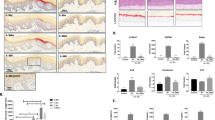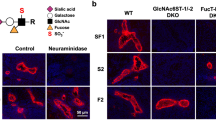Abstract
Specific interference with molecular mechanisms guiding tissue localization of leukocytes may be of great utility for selective immunosuppressive therapies. We have discovered and characterized efomycines, a new family of selective small-molecule inhibitors of selectin functions. Members of this family significantly inhibited leukocyte adhesion in vitro. Efomycine M, which was nontoxic and showed the most selective inhibitory effects on selectin-mediated leukocyte-endothelial adhesion in vitro, significantly diminished rolling in mouse ear venules in vivo as seen by intravital microscopy. In addition, efomycine M alleviated cutaneous inflammation in two complementary mouse models of psoriasis, one of the most common chronic inflammatory skin disorders. Molecular modeling demonstrated a spatial conformation of efomycines mimicking naturally occurring selectin ligands. Efomycine M might be efficacious in the treatment of human inflammatory disorders through a similar mechanism.
This is a preview of subscription content, access via your institution
Access options
Subscribe to this journal
Receive 12 print issues and online access
$209.00 per year
only $17.42 per issue
Buy this article
- Purchase on Springer Link
- Instant access to full article PDF
Prices may be subject to local taxes which are calculated during checkout






Similar content being viewed by others
References
Nickoloff, B.J. The cytokine network of psoriasis. Arch. Dermatol. 127, 871–884 (1991).
Schön, M.P. & Ruzicka, T. Psoriasis: The plot thickens... Nature Immunol. 2, 91 (2001).
Butcher, E.C. & Picker, L.J. Lymphocyte homing and homeostasis. Science 272, 60–66 (1996).
Springer, T. Traffic signals for lymphocyte recirculation and leukocyte emigration: The multistep paradigm. Cell 76, 301–314 (1994).
Varki, A. Selectin ligands. Proc. Natl. Acad. Sci. USA 91, 7390–7397 (1994).
Picker, L.J., Kishimoto, T., Smith, C.W., Warnock, R.A. & Butcher, E.C. ELAM-1 is an adhesion molecule for skin-homing T cells. Nature 349, 796–799 (1991).
Todderud, G. et al. BMS-190394, a selectin inhibitor, prevents rat cutaneous inflammatory reactions. J. Pharmacol. Exp. Ther. 282, 1298–1304 (1997).
Boehncke, W.H., Sterry, W., Hainzl, A., Scheffold, W. & Kaufmann, R. Psoriasiform architecture of murine epidermis overlying human psoriatic dermis transplanted onto scid mice. Arch. Dermatol. Res. 286, 325–330 (1994).
Nickoloff, B.J., Kunkel, S.L., Burdick, M. & Strieter, R.M. Severe combined immunodeficiency mouse and human psoriatic skin chimeras. Validation of a new animal model. Am. J. Pathol. 146, 580–588 (1995).
Schön, M.P., Detmar, M. & Parker, C.M. Murine psoriasis-like disorder induced by naive CD4+ T cells. Nature Med. 3, 183–188 (1997).
Larsen, E. et al. PADGEM-dependent adhesion of platelets to monocytes and neutrophils is mediated by a lineage-specific carbohydrate, LNF III (CD15). Cell 63, 467–474 (1990).
Weninger, W. et al. Specialized contributions by α(1,3)-fucosyltransferase-IV and FucT-VII during leukocyte rolling in dermal microvessels. Immunity 12, 665–676 (2000).
Robert, C. et al. Interaction of dendritic cells with skin endothelium: A new perspective on immunosurveillance. J. Exp. Med. 189, 627–236 (1999).
Christophers, E. The immunopathology of psoriasis. Int. Arch. Allergy Immunol. 110, 199–206 (1996).
Boehncke, W.-H., Dressel, D., Zollner, T.M. & Kaufmann, R. Pulling the trigger on psoriasis. Nature 379, 777 (1996).
Wrone-Smith, T. & Nickoloff, B.J. Dermal injection of immunocytes induces psoriasis. J. Clin. Invest. 98, 1878–1887 (1996).
Nickoloff, B.J. The immunologic and genetic basis of psoriasis. Arch. Dermatol. 135, 1104–1110 (1999).
Schröder, J.M., Gregory, H., Young, J. & Christophers, E. Neutrophil-activating proteins in psoriasis. J. Invest. Dermatol. 98, 241–247 (1992).
Schön, M.P. Animal models of psoriasis—what can we learn from them? J. Invest. Dermatol. 112, 405–410 (1999).
Morrissey, P.J., Charrier, K., Braddy, S., Liggitt, D. & Watson, J.D. CD4+ T cells that express high levels of CD45RB induce wasting disease when transferred into congenic severe combined immunodeficient mice. Disease development is prevented by cotransfer of purified CD4+ T cells. J. Exp. Med. 178, 237–244 (1993).
Powrie, F., Leach, M.W., Mauze, S., Caddle, L.B. & Coffman, R.L. Phenotypically distinct subsets of CD4+ T cells induce or protect from chronic intestinal inflammation in C.B-17 scid mice. Int. Immunol. 5, 1461–1471 (1993).
Schön, M., Denzer, D., Kubitza, R., Ruzicka, T. & Schön, M.P. Critical role of neutrophils for the generation of psoriasiform skin lesions in Flaky Skin mice. J. Invest. Dermatol. 114, 976–983 (2000).
Miller, K.E., Mukhopadhyay, C., Cagas, P. & Bush, C.A. Solution structure of the Lewis x oligosaccharide determined by NMR spectroscopy and molecular dynamics simulations. Biochemistry 31, 6703–6709 (1992).
Boehncke, W.H., Kock, M., Hardt-Weinelt, K., Wolter, M. & Kaufmann, R. The SCID-hu xenogeneic transplantation model allows screening of anti-psoriatic drugs. Arch. Dermatol. Res. 291, 104–106 (1999).
Dam, T.M., Kang, S., Nickoloff, B.J. & Voorhees, J.J. 1a,25-dihydroxycholecalciferol and cyclosporine suppress induction and promote resolution of psoriasis in human skin grafts transplanted onto SCID mice. J. Invest. Dermatol. 113, 1082–1089 (1999).
Schön, M.P., Homey, B. & Ruzicka, T. Antiphlogistics. Dermocorticoids and topical immunomodulators. in Dermatopharmacology of Topical Preparations. A Product Development-Oriented Approach (eds. Gabard, B., Elsner, P., Surber, C. & Treffel, P.) 179–190 (Springer, Berlin, 2000).
Gottlieb, J.L. et al. Response of psoriasis to a lymphocyte-selective toxin (DAB389 IL-2) suggests a primary immune, but not keratinocyte, pathogenic basis. Nature Med. 1, 442–447 (1995).
Falke, P., Elneihoum, A.M. & Ohlsson, K. Leukocyte activation: Relation to cardiovascular mortality after cerebrovascular ischemia. Cerebrovasc. Dis. 10, 97–101 (2000).
Barros, L.F.M., Coelho, I.J., Petrini, C.A., Chagas, A.C.P. & Silva, M.R.E. Myocardial reperfusion: Leukocyte accumulation in the ischemic and remote non-ischemic regions. Shock 13, 67–71 (2000).
Salmi, M. & Jalkanen, S. Endothelial ligands and homing of mucosal leukocytes in extraintestinal manifestations of IBD. Inflamm. Bowel Dis. 4, 149–156 (1998).
Goodarzi, M.T. et al. Sialyl Lewis(x) expression on IgG in rheumatoid arthritis and other arthritic conditions: A preliminary study. Glycoconj. J. 15, 1149–1154 (1998).
Srivastava, D. & Thompson, E.B. Two glucocorticoid binding sites on the human glucocorticoid receptor. Endocrinology 127, 1770–1778 (1990).
Peters, D.H., Fitton, A., Plosker, G.L. & Faulds, D. Tacrolimus. A review of its pharmacology and therapeutic potential in hepatic and renal transplantation. Drugs 46, 746–794 (1993).
Abraham, R.T. & Wiederrecht, G.J. Immunopharmacology of rapamycin. Annu. Rev. Immunol. 14, 483–510 (1996).
Schreiber, S.L. Chemistry and biology of the immunophilins and their immunosuppressive ligands. Science 253, 283–287 (1991).
Schreiber, S.L. & Crabtree, G.R. The mechanism of action of cyclosporin A and FK506. Immunol. Today 13, 136–142 (1992).
Sigal, N.H. & Dumont, F.J. Cyclosporine A, FK506 and rapamycin: Pharmacological probes of lymphocyte signal transduction. Annu. Rev. Immunol. 10, 519–525 (1992).
Bierer, B.E. et al. Two distinct signal transduction pathways in T lymphocytes are inhibited by complexes formed between an immunophilin and either FK506 or rapamycin. Proc. Natl. Acad. Sci. USA 87, 9231–9235 (1990).
Liu, J. et al. Calcineurin is a common target of cyclophilin–cyclosporin A and FKBP–FK506 complexes. Cell 66, 807–815 (1991).
Smith, C.H., Barker, J.N.W.N., Morris, R.W., MacDonald, D.M. & Lee, T.H. Neuropeptides induce rapid expression of endothelial cell adhesion molecules and elicit granulocytic infiltration in human skin. J. Immunol. 151, 3274–3282 (1993).
Bonfanti, R., Furie, B.C., Furie, B. & Wagner, D.D. PADGEM (GMP140) is a component of Weibel-Palade bodies of human endothelial cells. Blood 73, 1109–1112 (1989).
Bevilacqua, M.P., Stengelin, S., Gimbrone, M.A.J. & Seed, B. Endothelial leukocyte adhesion molecule-1: An inducible receptor for neutrophils related to complement regulatory proteins and lectins. Science 243, 1160–1163 (1989).
Hamann, P., Kretzschmar, G. & Seibert, G. Secondary metabolites by chemical screening 7.I. Elaiophylin derivatives and their biological activities. J. Antibiot. 43, 1431–1440 (1990).
Detmar, M., Tenorio, S., Hettmannsperger, U., Ruszczak, Z. & Orfanos, C.E. Cytokine regulation of proliferation and ICAM-1 expression of human dermal microvascular endothelial cells in vitro. J. Invest. Dermatol. 98, 147–153 (1992).
Picker, L.J. et al. Control of lymphocyte recirculation in man. II. Differential regulation of the cutaneous lymphocyte-associated antigen, a tissue-selective homing receptor for skin-homing T cells. J. Immunol. 150, 1122–1136 (1993).
Acknowledgements
We thank R. Kubitza, J. Herz, and K. Hardt-Weinelt for technical assistance; I. Kruse, I. Hagelschuer and M. Kock for help with animal care; O. Gutbrod and D. Gondol for help with analysis of three-dimensional molecular structures; M. Kazinski for help with cell sorting; and T. Henkel and K. Weber for compound synthesis.
Author information
Authors and Affiliations
Corresponding authors
Ethics declarations
Competing interests
T.K. has taken over a patent on the use of efomycines. However, there is no financial gain or benefit foreseeable and no financial profit has been made.
Rights and permissions
About this article
Cite this article
Schön, M., Krahn, T., Schön, M. et al. Efomycine M, a new specific inhibitor of selectin, impairs leukocyte adhesion and alleviates cutaneous inflammation. Nat Med 8, 366–372 (2002). https://doi.org/10.1038/nm0402-366
Received:
Accepted:
Issue Date:
DOI: https://doi.org/10.1038/nm0402-366
This article is cited by
-
The clinical impact of glycobiology: targeting selectins, Siglecs and mammalian glycans
Nature Reviews Drug Discovery (2021)
-
Naturally occurring cell adhesion inhibitors
Journal of Natural Medicines (2018)
-
PS3, A Semisynthetic β-1,3-Glucan Sulfate, Diminishes Contact Hypersensitivity Responses Through Inhibition of L- and P-Selectin Functions
Journal of Investigative Dermatology (2009)
-
From carbohydrate leads to glycomimetic drugs
Nature Reviews Drug Discovery (2009)
-
Iron Chelators and Hypoxia Mimetics Inhibit IFNγ-Mediated Jak-STAT Signaling
Journal of Investigative Dermatology (2009)



